A Sustainable Approach to Reconstruction: Historical Roof Structure Interventions
Abstract
1. Introduction
- Historical roof structure reconstructions: The lives of certain historic buildings have undergone significant changes due to damage caused by wars, fires, and the installation of new roofs, as demonstrated using European examples from Romania (church building in Sighișoara, Aiud, Timișoara, and Turda).
- Reconstructions following hazards since the 19th century (Chartres, Reims in France, Lübeck in Germany, St. Stephen’s Dome in Vienna, Venice Theatre in Italy), during which unique reconstructions were chosen based on specific criteria, utilizing materials other than wood.
- Current reconstructions (Church in Bistrița, Monastery in Vințu de Jos).
- Roofs for ruins or heavily degraded buildings (Păuca, Comlod).
2. Importance of Roofs for Buildings: Analysis Criteria
- Conceptual criterion;
- Structural performance criterion;
- Sustainability criterion.
| Analysis Criteria | Main Problems |
|---|---|
| Conceptual criterion | Cultural heritage recovery versus general recovery Rebuilding, nearly rebuilding, contemporary redesign Materials, roof shape Fire resistance, weight |
| Structural performance criterion | Durability Strength, stability, service safety Structure behaviour |
| Sustainability criterion | Materials for structural interventions (joints) Material’s renewability |
2.1. Conceptual Criterion
2.2. Structural Performance Criterion
2.3. Sustainability Criterion
3. Historic Structures and Disasters: Learning from Historical Case Studies
3.1. Roof Structures and Disasters
3.2. Other Interventions on Historic Roof Structures after Disasters: Examples—Learning from Historical Interventions
3.2.1. Chartres Cathedral Roof Structure
3.2.2. Reims Cathedral Roof Structure
3.2.3. Lübeck Cathedral Roof Structure
3.2.4. La Fenice Theatre Roof Structure
4. Current Reconstructions
4.1. Bistrița Evangelical Church Roof Structure
- Value record. The roof structures;
- Post-fire interventions
- Analysis of the roof structure over the nave
4.2. Structural Analysis of the Nave’s Roof Structure
4.3. Monastery Complex in Vințu de Jos, Romania
5. Temporary Roofs above Ruined Buildings
5.1. Păuca: Ruined Reformed Church
5.2. Comlod: Ruined Teleki Mansion
6. Conclusions
Author Contributions
Funding
Institutional Review Board Statement
Informed Consent Statement
Data Availability Statement
Acknowledgments
Conflicts of Interest
References
- Rosasco, P.; Perini, K. Selection of (Green) Roof Systems: A Sustainability-Based Multi-Criteria Analysis. Buildings 2019, 9, 134. [Google Scholar] [CrossRef]
- Icomos-Iccrom Guidance on Post-Disaster and Post-Conflict Recovery and Reconstruction. Available online: https://www.iccrom.org/sites/default/files/publications/2024-02/en_icomos-iccrom_guidance_iccrom_2024.pdf (accessed on 14 March 2024).
- Chen, C.X.; Pierobon, F.; Jones, S.; Maples, I.; Gong, Y.; Ganguly, I. Comparative Life Cycle Assessment of Mass Timber and Concrete Residential Buildings: A Case Study in China. Sustainability 2022, 14, 144. [Google Scholar] [CrossRef]
- Kincaid, S. After the Fire: Reconstruction following Destructive Fires in Historic Buildings. Hist. Environ. Policy Pract. 2020, 11, 21–39. [Google Scholar] [CrossRef]
- Laurila, A. (Ed.) Can We Learn from the Heritage Lost in a Fire: Experiences and Practises on the Fire Protection of Historic Buildings in Finland, Norway and Sweden (Publication No 26); National Board of Antiquities, Department of Monuments and Sites: Helsinki, Finland, 2004.
- SR EN 15804+A2:2020—Sustenabilitatea lucrărilor de construcții (European Standard).
- International Charter for the Conservation and Restoration of Monuments and Sites (the Venice Charter 1964). Available online: https://www.icomos.org/images/DOCUMENTS/Charters/venice_e.pdf (accessed on 14 March 2024).
- Revision of the Burra Charter in 2013. Available online: https://australia.icomos.org/wp-content/uploads/The-Burra-Charter-2013-Adopted-31.10.2013.pdf (accessed on 14 March 2024).
- Riga Charter on Authenticity and Historical Reconstruction in Relationship to Cultural Heritage. 2000. Available online: https://www.iccrom.org/sites/default/files/publications/2020-05/convern8_07_rigacharter_ing.pdf (accessed on 14 March 2024).
- Kincaid, S. Fire prevention in historic buildings—Approaches for safe practice. Hist. Environ. Policy Pract. 2022, 13, 361–380. [Google Scholar] [CrossRef]
- Andreescu, I.; Keller, A.; Mosoarca, M. Complex Assessment of Roof Structures. Procedia Eng. 2016, 161, 1204–1210. [Google Scholar] [CrossRef]
- Tóth, B.; Ziegler, Á. Dendrochronological Analysis on the Roof Structures of the Dominican Monastery Church in Sighișoara; Transsylvania Nostra: No. 3/2022; Utilitas Publishing House: Cluj-Napoca, Romania, 2022; ISSN 1842-5631. pp. 2–21. [Google Scholar]
- Diplich, H. Die Domkirche in Temeswar; Verlag des Sudostdeutschen Kulturwerkes: München, Germany, 1972; pp. 33–47. [Google Scholar]
- Szabo, B.; Kirizsán, I. Dicționar Ilustrat de Șarpante Istorice; Utilitas Publishing House: Cluj-Napoca, Romania, 2010. [Google Scholar]
- Szabó, B. Illustrated Dictionary of Historic Load-bearing Structures; Kriterion Publishing House: Cluj-Napoca, Romania, 2005; ISBN 973-26-0810-2. [Google Scholar]
- Santiago, H. The Debate about the Structural Behaviour of Gothic Vaults: From Viollet-le-Duc to Heyman. In Proceedings of the Third International Congress on Construction History, Cottbus, Germany, 20–24 May 2009. [Google Scholar]
- Bulteau, M.J. Monographie de la Cathédrale de Chartres; Librairie L. Selleret: Chartres, France, 1887; pp. 259–260. [Google Scholar]
- Eck, C. Traité de L’application du fer, de la Fonte et de la tôle Dans Toutes les Constructions; Dalmont, V., Ed.; Corps des Ponts et Chaussées: Paris, France, 1841; pp. 33–38. [Google Scholar]
- Deneux, H. Les “Cretiaus” de la chatédrale de Reims. In Bulletin Monumental; Tome CIV: Paris, France, 1946; pp. 109–112. [Google Scholar]
- Hoffsummer, P. Les Charpentes de Toitures en Wallonie; Typologie et dendrochronology (XI–XIX siècle), Etudes et Documents Monuments et Sites; Ministère de la Région Wallonne: Jambes, Belgium, 1999; p. 162. [Google Scholar]
- Delorme, P. Nouvelles Inventions Pour Bien Bastir et a Petits Fraiz. Available online: https://gallica.bnf.fr/ark:/12148/bpt6k85634s (accessed on 14 March 2024).
- Pieper, K. Sicherung Historischer Bauten; Verlag von Wilhelm Ernst & Sohn: Berlin, Germany; München, Germany, 1983; pp. 127–141. [Google Scholar]
- Memoria Storica del Teatro la Fenice in Venezia; Presso Giuseppe Orlandelli: Venezia, Italy, 1839; p. 10.
- Riedificazione del Teatro la Fenice; Tipografia Erede Picotti: Venezia, Italy, 1840; p. 23.
- Barbisan, U.; Laner, F. Capriate e Tetti in Legno; Progetto e Recupero, FancoAngeli Publishing House: Milano, Italy, 2000; p. 10. [Google Scholar]
- Fabbri, E. Il Ritorno della Fenice. Mostra sulla Ricostruzione Artistica del Teatro La Fenice. Available online: https://architettura.unige.it/did/l2/architettura/quarto0607/labrestauroa/galleria/fenice.pdf (accessed on 14 March 2024).
- Dahinten, O. Geschichte der Stadt Bistritz in Siebenbürgen; Ernst Wagner Publishing House, Böhlau Verlag: Köln-Viena, Austria, 1988; p. 238. [Google Scholar]
- Kirizsán, I.; Szabó, B.; Vass, L. Interventions on the Gothic Roof Structure of the Nave at the Lutheran Church in Bistriţa (Romania). Adv. Mater. Res. 2010, 133–134, 1051–1056. [Google Scholar] [CrossRef]
- Iringová, A.; Idunk, R. Solution of Fire Protection in Historic Buildings. Civ. Environ. Eng. 2016, 12, 84–93. [Google Scholar] [CrossRef][Green Version]
- Drdácký, M.; Mlázovský, V.; Růžička, P. Lessons from Historic Carpentry. In European Research on Cultural Heritage; Drdácký, M., Ed.; Institute of Theoretical and Applied Mechanics, Academy of Sciences of the Czech Republic: Praha, Czech Republic, 2006; Volume 4, pp. 327–344. [Google Scholar]
- Garcia-Castillo, E.; Paya-Zaforteza, I.; Hospitaler, A. Fire in heritage and historic buildings, a major challenge for the 21st century. Dev. Built Environ. 2023, 13, 100102. [Google Scholar] [CrossRef]
- Draft. ICOMOS Guidelines for Protecting Our Cultural Heritage from the Effects of Fire. Available online: https://www.icomos.org/images/DOCUMENTS/General_Assemblies/GA2020_Sydney/Working_documents/December_GA2020_Working_Docs/GA202012_6_Resolutions_final_EN.pdf (accessed on 14 March 2024).
- Tupenaite, L.; Kanapeckiene, L.; Naimaviciene, J.; Kaklauskas, A.; Gecys, T. Timber Construction as a Solution to Climate Change: A Systematic Literature Review. Buildings 2023, 13, 976. [Google Scholar] [CrossRef]
- Utilitas Built Heritage Conservation Research and Design Centre, Project no 397/2018—The Conservation of the Evangelical Church A.C. in Bistrița, with the Aim of Introducing it in the International Tourism Circuit (manuscript).



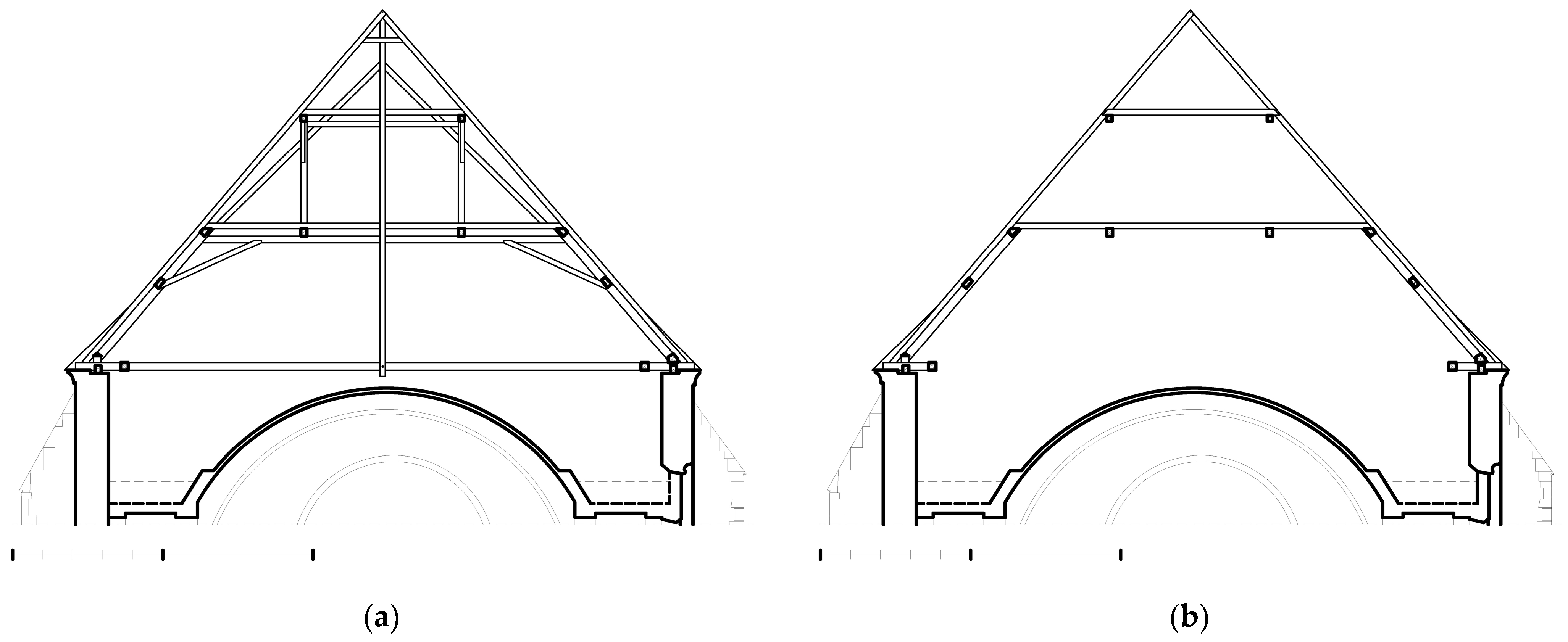

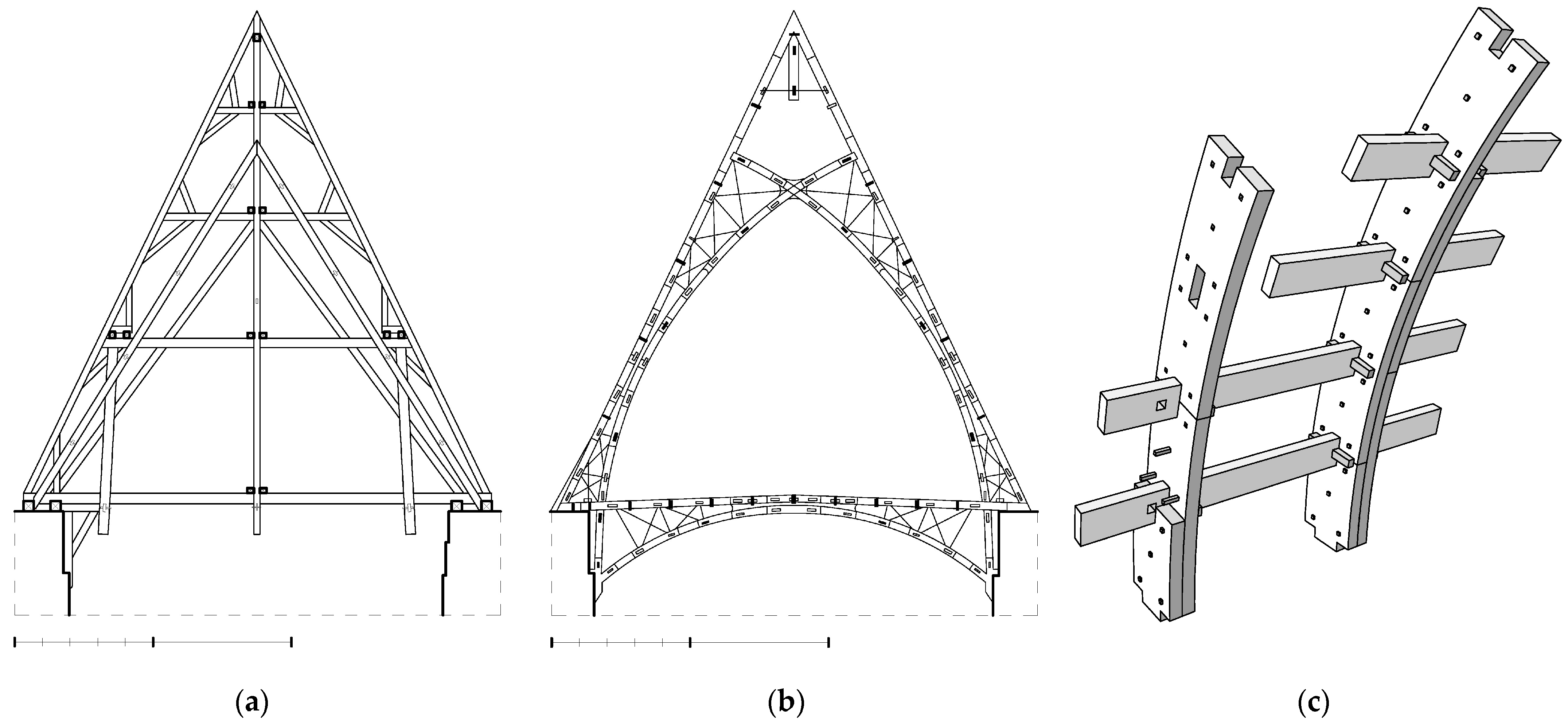

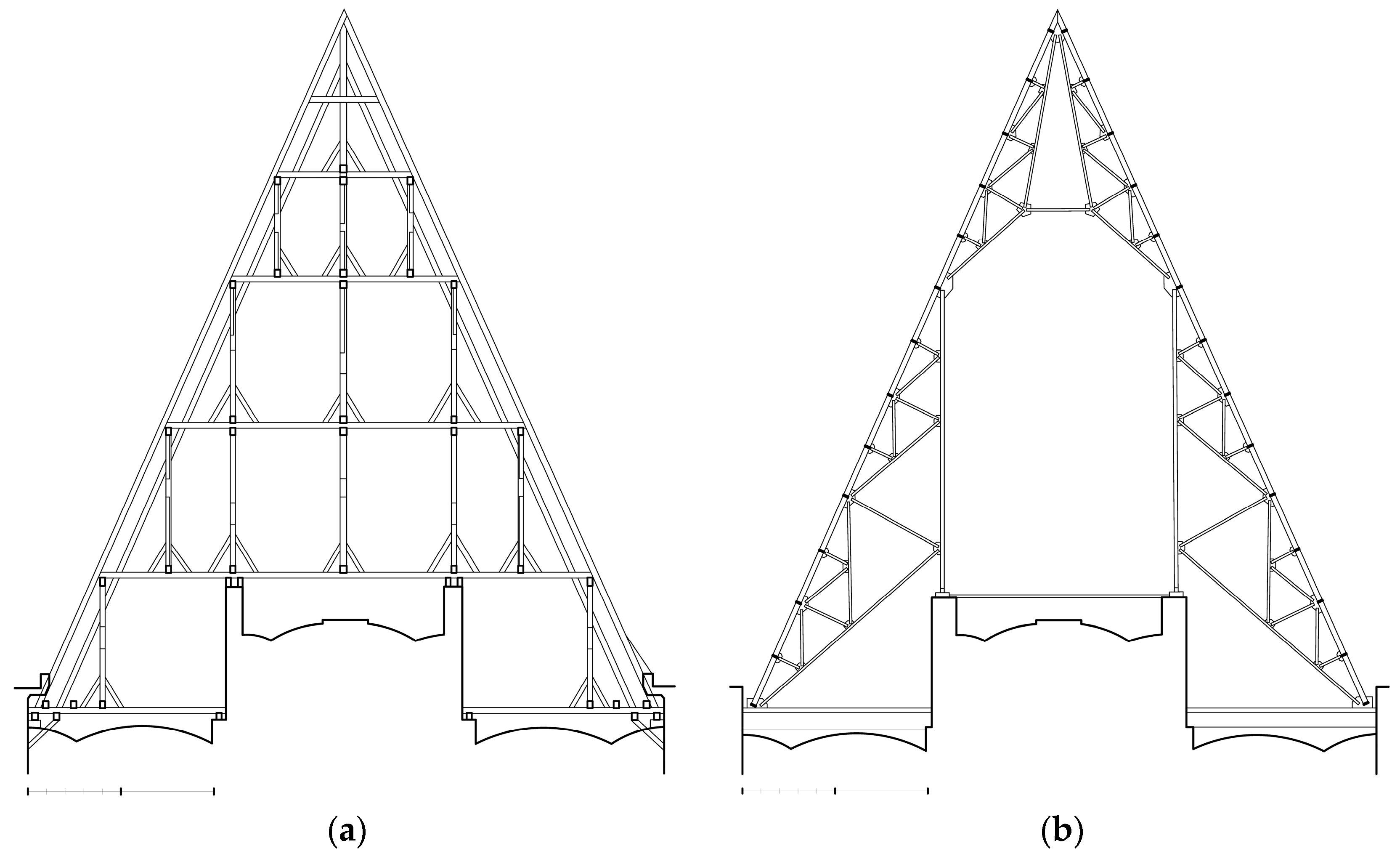


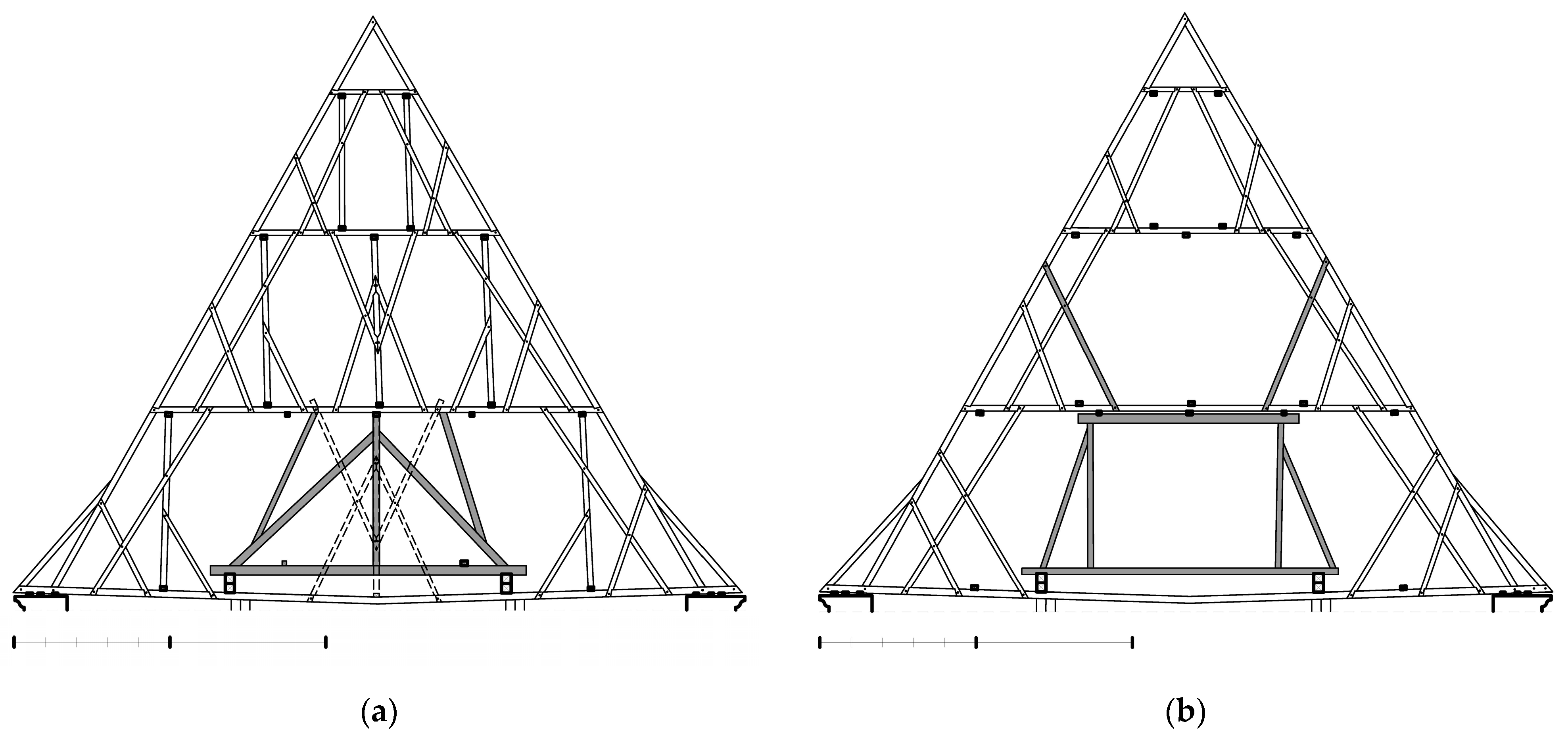
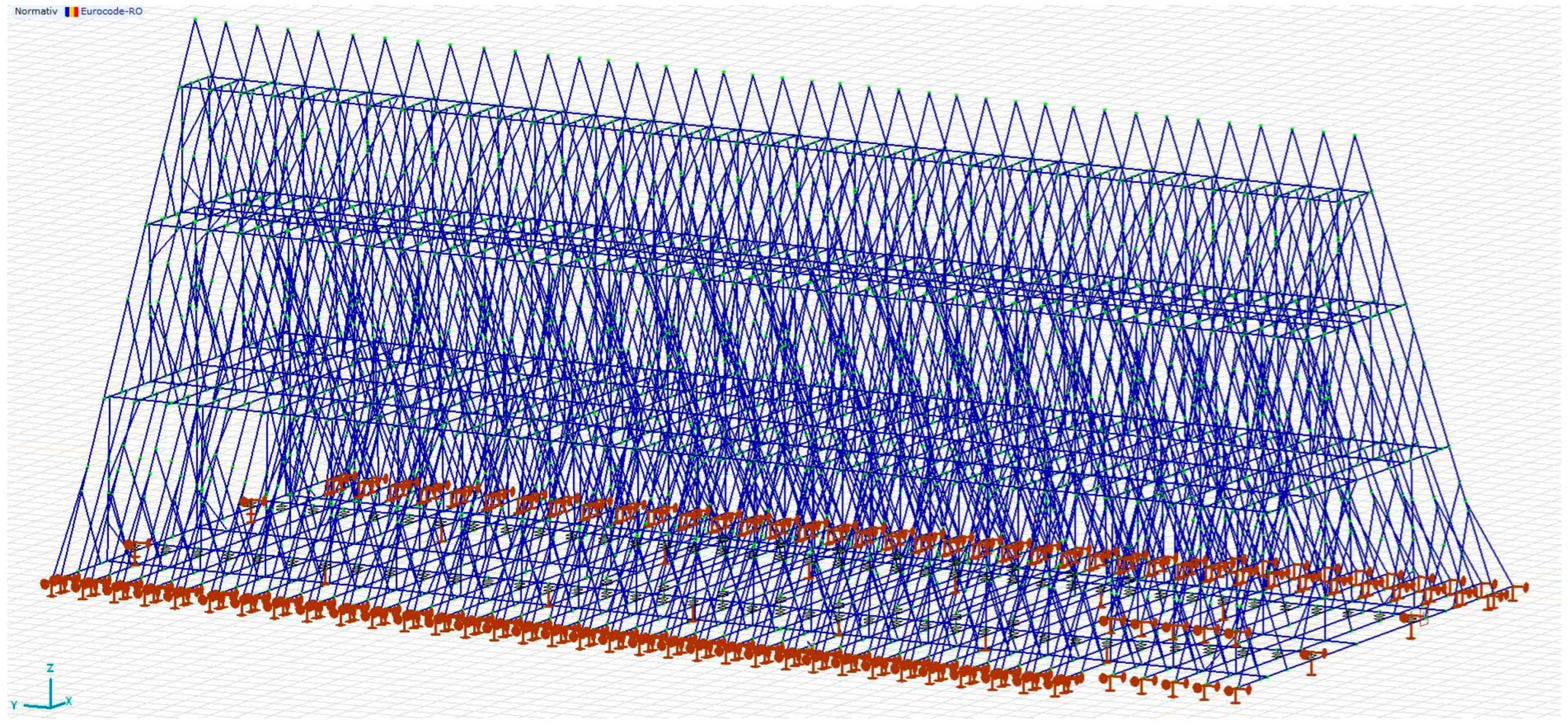
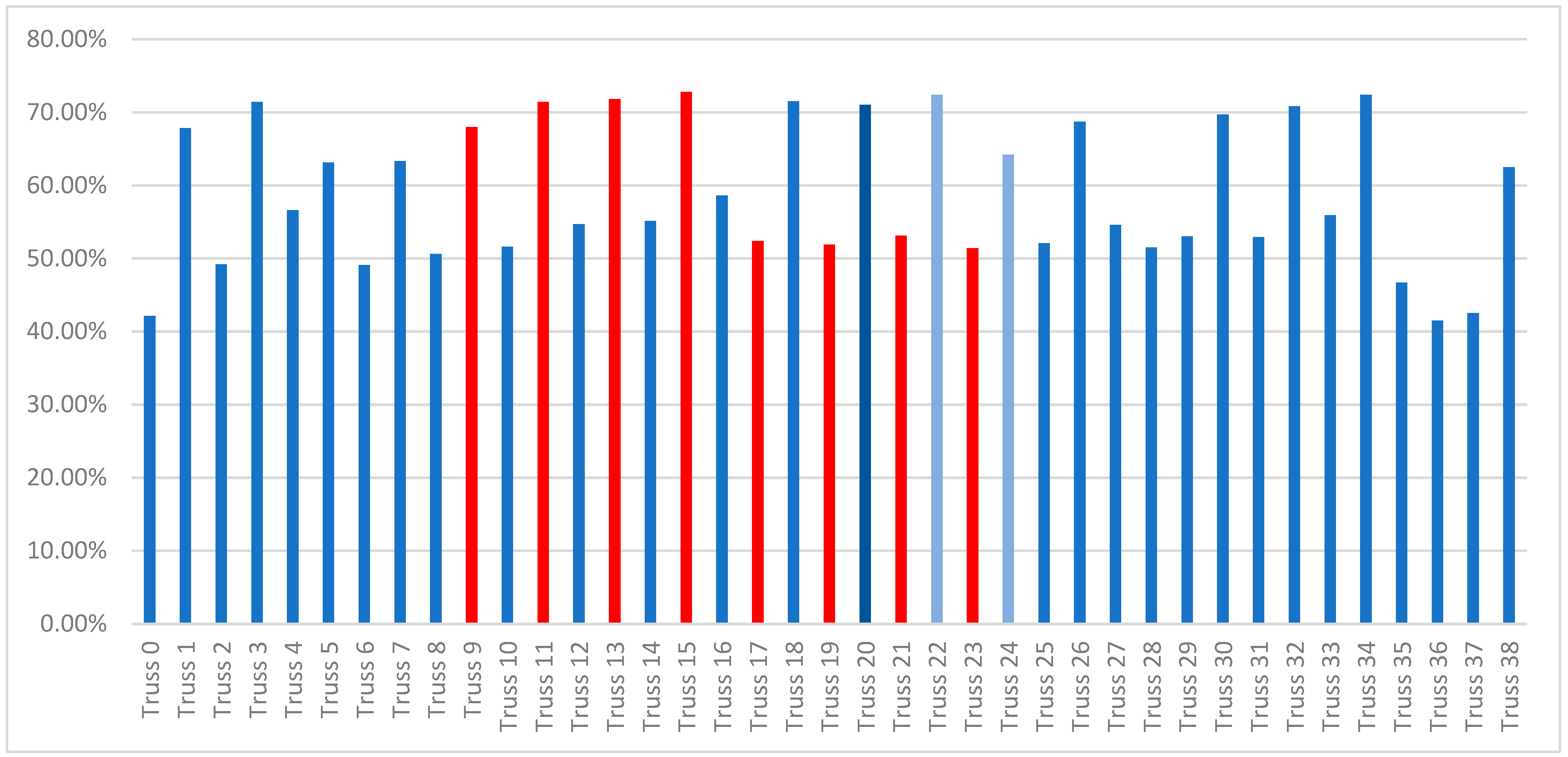

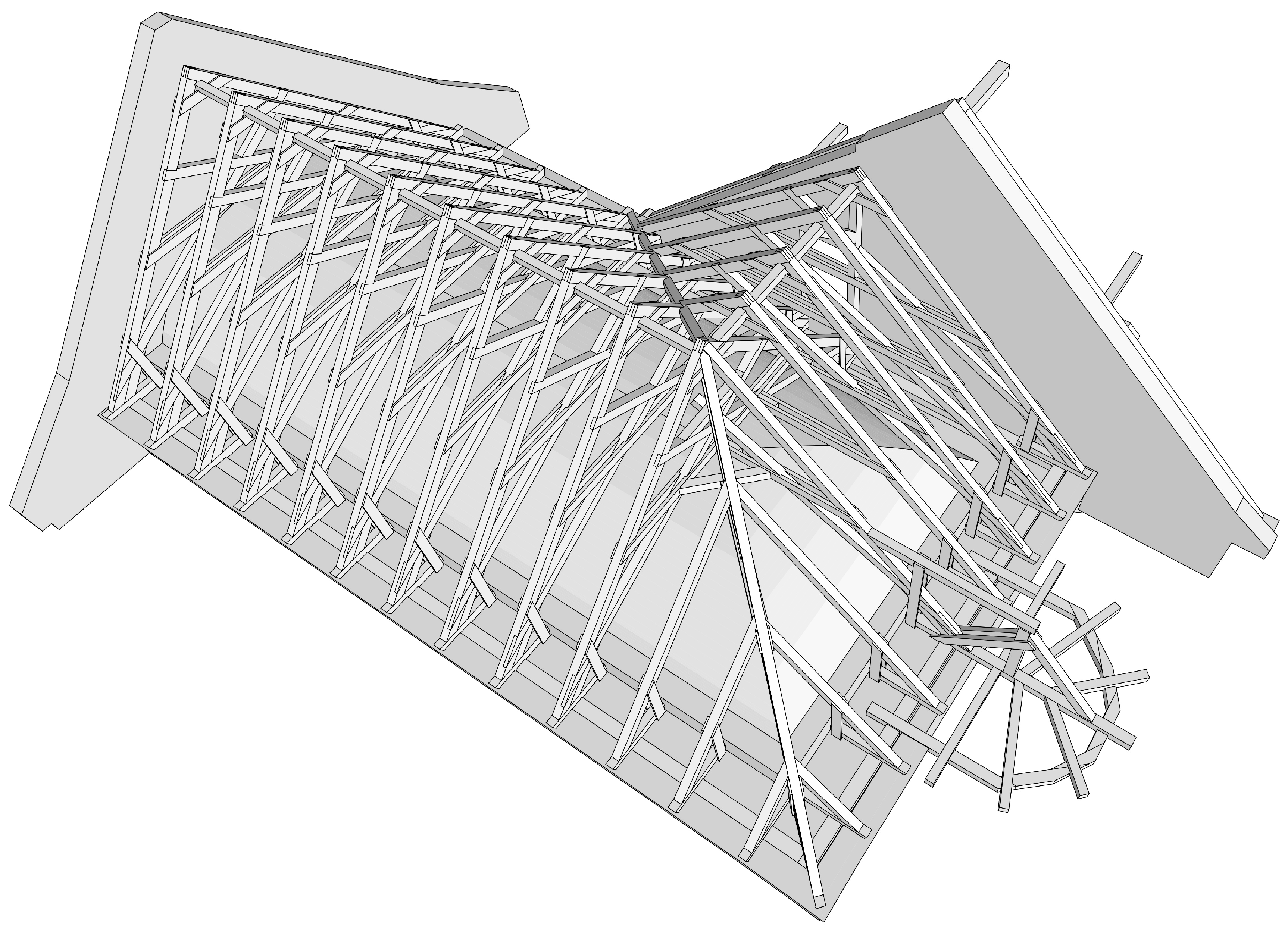

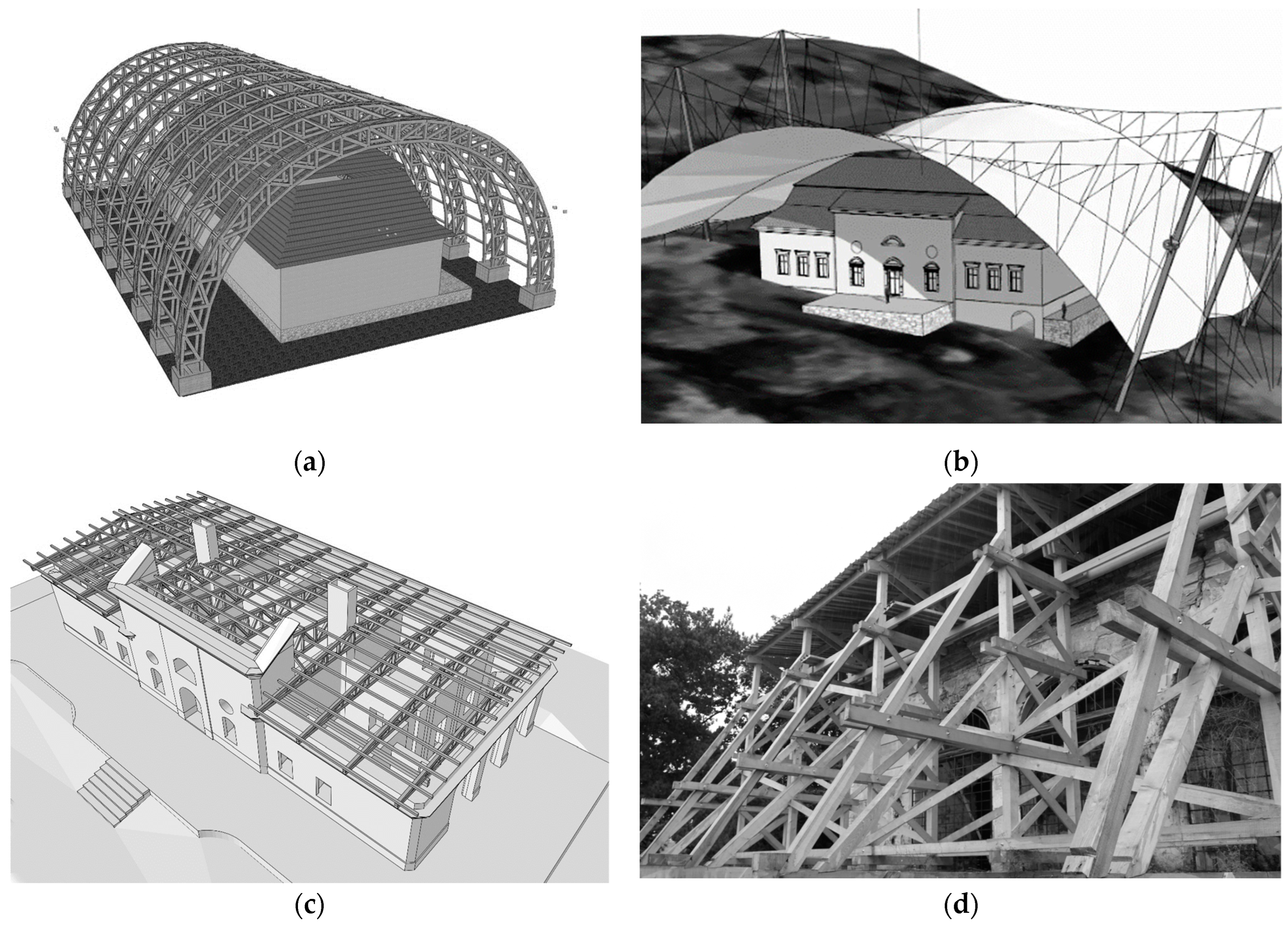
| Type of Roof Covering Material | Gravity Load daN/m2 | Overload [%] | Reusable | Recyclable | Guaranteed Lifetime Years | kg CO2e/kg |
|---|---|---|---|---|---|---|
| Pinewood shingle | 40 | NO | YES | 20 | 8.9 | |
| Metal sheet (flat) | 30 | NO | YES | 50 | 17.5 | |
| Beavertail plain tile with single lap tiling | 65 | A surplus of 62.5% as compared to shingle | YES | YES | 40–50 | 31.2 |
| Ceramic tile with double or compact lap tiling | 85 | A surplus of 112.5% as compared to shingle | YES | YES | 40–50 | 38.4 |
| Extruded tile | 50 | A surplus of 25% as compared to shingle | YES | YES | 40–50 | 28.8 |
| Location (Locality/County) | Span (m) Slope (°) | Roof Structure Roofing | Reconstruction Variant | Reconstruction Period | New Materials |
|---|---|---|---|---|---|
| Reims/France | 15.00 | Timber (oak) | c | 1920 | Reinforced concrete |
| 64.2 | Lead | Lead | |||
| Chartres/France | 14.20 | Timber (oak) | c | 1841 | Iron, cast iron |
| 58.10 | Lead | Copper | |||
| Lübech/Germany | 15.50 | Timber (oak) | c | 1947–1952 | Reinforced concrete |
| 51.10 | Lead | Copper | |||
| Aiud/Romania | 18.80 | Timber (spruce) | b | 1790, 1850 | Timber (spruce) |
| 44.40 | Ceramic tiles | Ceramic tiles | |||
| Turda/Romania | 19.20 | Timber (spruce) | b | 1820 | Timber (spruce) |
| 49.50 | Ceramic tiles | Ceramic tiles | |||
| Sighișoara/Romania | 14.00 | Timber (oak) | c | 1677 | Timber (spruce) |
| 72.20 | Ceramic tiles | Ceramic tiles | |||
| Timișoara/Romania | 17.80 | Timber (oak, spruce) | c | 1735–1774 | Timber (spruce) |
| 39.90 | Ceramic tiles | Ceramic tiles | |||
| Bistrița/Romania | 21.50 | Timber (spruce) | a, b | 2009–2023 | Timber (spruce) |
| 59.90 | Ceramic tiles | Ceramic tiles |
| Location (Locality/County) | Reconstruction Variant | Timber Consumption Cubic Meters/Square Meters | Price Euro/Square Meters |
|---|---|---|---|
| Comlod/Romania | 1 | 0.18 | 334 |
| 2 | 399 | ||
| 3 | 141 | ||
| 4 | 225 | ||
| Păuca/Romania | 0.05 | 65 |
Disclaimer/Publisher’s Note: The statements, opinions and data contained in all publications are solely those of the individual author(s) and contributor(s) and not of MDPI and/or the editor(s). MDPI and/or the editor(s) disclaim responsibility for any injury to people or property resulting from any ideas, methods, instructions or products referred to in the content. |
© 2024 by the authors. Licensee MDPI, Basel, Switzerland. This article is an open access article distributed under the terms and conditions of the Creative Commons Attribution (CC BY) license (https://creativecommons.org/licenses/by/4.0/).
Share and Cite
Kirizsán, I.; Tudoreanu-Crișan, A. A Sustainable Approach to Reconstruction: Historical Roof Structure Interventions. Sustainability 2024, 16, 4325. https://doi.org/10.3390/su16114325
Kirizsán I, Tudoreanu-Crișan A. A Sustainable Approach to Reconstruction: Historical Roof Structure Interventions. Sustainability. 2024; 16(11):4325. https://doi.org/10.3390/su16114325
Chicago/Turabian StyleKirizsán, Imola, and Adrian Tudoreanu-Crișan. 2024. "A Sustainable Approach to Reconstruction: Historical Roof Structure Interventions" Sustainability 16, no. 11: 4325. https://doi.org/10.3390/su16114325
APA StyleKirizsán, I., & Tudoreanu-Crișan, A. (2024). A Sustainable Approach to Reconstruction: Historical Roof Structure Interventions. Sustainability, 16(11), 4325. https://doi.org/10.3390/su16114325








